


The Vietnam War and World War II

(Click to Enlarge)
Most of the young men who served on Dawg Flight at Shulinkou Air Station from 1967 through 1972 were high school students when the U.S. became embroiled in the Vietnam conflict. As our involvement in Vietnam escalated during the mid-1960s, male students had few options upon graduation from high school. Like their fathers during the Second World War, they faced being drafted or enlisting, or possibly receiving a draft deferment for college or other reasons. Due to the Vietnam War, my high school class of 1966 surpassed the record established during World War II for graduating seniors who had already enlisted, received draft notices, or planned to enter the military that year.
During email exchanges between members of Dawg Flight and others in August 2010, many shared their fathers' and relatives' World War II military experiences. Those experiences have been compiled in the excerpts that follow from their emails. 'Lest we forget' all the brave man and women who served and gave their lives for freedom.
(image source: unknown)
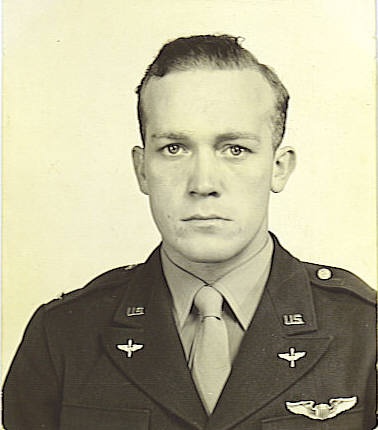

 (Click to Enlarge) (1.) Capt, William B. Barnes pilot WWII. (2.) 2nd Lt. William Barnes and B-24 crew. (3.) Colonel Barnes, Shulinkou 1970.
(Click to Enlarge) (1.) Capt, William B. Barnes pilot WWII. (2.) 2nd Lt. William Barnes and B-24 crew. (3.) Colonel Barnes, Shulinkou 1970.
Colonel William "Bud" Barnes (1921-2006), Shulinkou Air Station's base commander from June 27, 1969 to June 27, 1971, was awarded the Air Force "Distinguished Flying Cross" while flying B-24s as lead pilot (rank of captain) on 27 combat missions with the 392nd Bomb Group in Europe during World War II.
photo credits: (1. & 2.) "392nd Memorial Association" archives (www.B24.net) (3.) July 2, 1970 "Shulinkou Devil Dog" newspaper ("DawgFlight.com").
"My wife's uncle, her mother's brother, was on the USS Arizona on that fateful day, December 7th, 1941, and was killed. He is still buried on the ship. The local VFW in Hoopeston, Illinois is named after him, the Buddy Egnew VFW." - "Butch" K.
 (Click to Enlarge) Corporal R. Higgins, USMC 1942-1945.
(Click to Enlarge) Corporal R. Higgins, USMC 1942-1945.
"My dad (photo on left) enlisted in the USMC in April of 1942 at Augusta, Maine, and was soon at Parris Island, S.C. and New River, NC. After that he was in action in the Solomon Islands at Guadalcanal, Gilbert Islands at Tarawa, and New Guinea. He served in the Third Marines under Major General Alexander A. Vandegrift. He served on the USS St. Paul ("CA 73"), which was also at the signing of the Japanese surrender in Tokyo Bay on September 02, 1945 on the USS Missouri. He was discharged from Charlestown Naval Yard, Boston, Massachusetts in spring of 1946." - L. Higgins (photo source: L. Higgins)
"My dad was a Marine, 1st Division, and was at Tarawa. He never discussed his combat experiences." - B. Bonar

 (Click to Enlarge) Curtiss C-46 Commando and Douglas C-47 Skytrain in flight over the snowcapped mountains of the "Hump". (USAAF photos)
(Click to Enlarge) Curtiss C-46 Commando and Douglas C-47 Skytrain in flight over the snowcapped mountains of the "Hump". (USAAF photos)
 "My grandmother proudly displayed six blue stars (image on right) in her window to show she had six sons serving in the military during World War II. Thankfully, all six returned home along with three purple hearts. My father (her son) was a flight engineer who flew C-46's and C-47's (photos on left) between India and Kunming, China, and also spent time in Burma. Toward the end of the war he was stationed in Africa, generally French West Africa and Belgian Congo. He was called back during the Korean War, and was assigned to an Air Police Squadron in Fukuoka, Japan, since he had been a Long Beach police officer,
"My grandmother proudly displayed six blue stars (image on right) in her window to show she had six sons serving in the military during World War II. Thankfully, all six returned home along with three purple hearts. My father (her son) was a flight engineer who flew C-46's and C-47's (photos on left) between India and Kunming, China, and also spent time in Burma. Toward the end of the war he was stationed in Africa, generally French West Africa and Belgian Congo. He was called back during the Korean War, and was assigned to an Air Police Squadron in Fukuoka, Japan, since he had been a Long Beach police officer,
Another son, my uncle Phil, who is now 85 [2010], was in the first wave at Iwo Jima, 5th Marine Division. He still carries shrapnel in his back from a hand grenade. That experience has been the defining event of his life. He has a whole room in his house with Marine memorabilia, and even donated one of his uniforms to the WWII museum in Laughlin, Nevada. God bless all those brave men who sacrificed so much, so long ago." - C. Castillo
(right image credit: unknown)
"My wife's dad was also in the first wave at Iwo Jima, 5th Marine Division. I’m sure somewhere along the way our family's dads and relatives knew each other and perhaps fought side-by-side." - B. Weagle
(Click to Enlarge) The monument on Iwo Jima's Mount Suribachi, located where six Marines famously raised the American flag during the battle in 1945. The Marine emblems on both sides the monument are covered by dog tags left by visiting veterans honoring the 6,821 Americans killed. (photo credit: unknown)
 "My dad was in World War II and served in the CBI (China, Burma, India) theater. He was an Army Captain and worked on the Burma Road, and claimed to have been in the first convoy to use it when it was completed. He was in China, Burma and India. I still have some of his CBI patches (image on left) and other items he got from over there. Reading about all the fathers, uncles, and relatives who served in WWII makes me wonder how the next generation will view us." - "Mac"
"My dad was in World War II and served in the CBI (China, Burma, India) theater. He was an Army Captain and worked on the Burma Road, and claimed to have been in the first convoy to use it when it was completed. He was in China, Burma and India. I still have some of his CBI patches (image on left) and other items he got from over there. Reading about all the fathers, uncles, and relatives who served in WWII makes me wonder how the next generation will view us." - "Mac"
(Click to Enlarge) CBI shoulder patch worn during WWII for service in the China, Burma, and India theater of operations.
(image source: unknown)
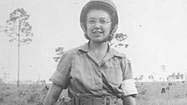 "My father's brother served with the Army Air Force in the Philippines. My mother's brother served with the Army Air Force in the jungles of Burma. A neighbor in my hometown was a 1st Lieutenant in the Army Nurse Corps (1944 photo on left taken in France) , assigned to the 34th Evacuation Hospital. She landed on Utah Beach June 22, 1944, with General George Patton's 3rd army. She followed Patton during the invasion of Europe."
"My father's brother served with the Army Air Force in the Philippines. My mother's brother served with the Army Air Force in the jungles of Burma. A neighbor in my hometown was a 1st Lieutenant in the Army Nurse Corps (1944 photo on left taken in France) , assigned to the 34th Evacuation Hospital. She landed on Utah Beach June 22, 1944, with General George Patton's 3rd army. She followed Patton during the invasion of Europe."
In her words: "We worked our butts off in the 34th Evac, 12 hours a day, seven days a week, week in and week out with very little time off. We were where the fighting was taking place, but in spite of that, we could not possibly visualize nor comprehend what life was like on the front lines, in the thick of battle. We saw the results of the fighting and tried to heal the mangled bodies brought to us. We took care of 27,477 soldiers."- "Sarge" (photo source: "mcall.com")
 (Click to Enlarge)
"The photo of my father (on left) was taken at Parris Island in 1951 during the Korean War. Although my father served in World War II, he was called back up for the Korean War." "My father was a Marine officer (...right up to the day he passed on...) and made the invasion of Guam in 1943. A short fourteen years later our entire family was moving to Guam where he had taken a job as a civilian with the Air Force. We lived there from 1957 to 1961. So I was age ten through fourteen while there.
(Click to Enlarge)
"The photo of my father (on left) was taken at Parris Island in 1951 during the Korean War. Although my father served in World War II, he was called back up for the Korean War." "My father was a Marine officer (...right up to the day he passed on...) and made the invasion of Guam in 1943. A short fourteen years later our entire family was moving to Guam where he had taken a job as a civilian with the Air Force. We lived there from 1957 to 1961. So I was age ten through fourteen while there.
My father never made mention of the war or his experiences. Neither while we were living on Guam or thereafter. Just something that you could sense he didn't want to talk about nor did we ever ask. So common among many veterans who have experienced combat. I do know that he had some hearing loss in one ear that resulted from being lifted off his feet by a grenade. Yet I wonder today what must have been going through his mind as we lived there those years on that island only 50 miles long and 10 miles wide at the most.
While our family was living on Guam, we would frequent the many beaches of the island. Of course most of those same beaches were the ones that 3rd Marine Division and others came ashore. My memory of those beaches are of the numerous pill boxes built by the Japanese on the beaches' edge and were still remaining. Concrete bunkers that probably held four soldiers at the most. Us kids would sift our hands down through the sand next to those pill boxes and bring up brass ammunition casings that had been buried there well after the Japanese were routed out. Finding the casings was neat for us kids, but little did we know or understand the significance. Only that they seemed to be fun to collect. ...You might be thinking 'was there any live ammo in those sands...?' Well, the thought never crossed our minds, or our parents, as we collected those casings." N. Carpenter (photo source: N. Carpenter)
 "My father served with the Marines in the Pacific during WWII. Eddie Lebaron (photo on right-clck to enlarge), QB for the Cowboys and Redskins many moons ago, was my father's commanding officer on Guam." - "Gordy" (photo source: "profootballhof.com")
"My father served with the Marines in the Pacific during WWII. Eddie Lebaron (photo on right-clck to enlarge), QB for the Cowboys and Redskins many moons ago, was my father's commanding officer on Guam." - "Gordy" (photo source: "profootballhof.com")
 (Click to Enlarge) USS Bunker Hill hit by two kamikazes in 30 seconds on 11 May 1945 off Kyushu during the battle for Okinawa. (U.S. Navy military archives photo)
(Click to Enlarge) USS Bunker Hill hit by two kamikazes in 30 seconds on 11 May 1945 off Kyushu during the battle for Okinawa. (U.S. Navy military archives photo)
"My dad was a fighter pilot in the US Navy aboard the aircraft carrier Bunker Hill. After flying missions over the Gilbert Islands, the Marshall Islands, Iwo Jima, and the Japanese Islands, he was severely wounded when the Bunker Hill was struck by two kamikaze aircraft in May of 1945, during the Okinawa campaign (photo on left).
372 were killed in the attack; Dad, was one of 264 wounded. He was flown back to the States and eventually recovered his health well enough to marry my mother. He told me she would only agree to marry him if he could walk down the aisle of the church on his own two legs.
My dad did indeed walk down the aisle for their wedding, and he continued to walk on his own the rest of his life. Mom and dad were married 55 years. He suffered second and third degree burns over 30 percent of his body in the war, but that didn't stop him from using the GI Bill to graduate from Duke, get a Masters from Northwestern, and become a successful CPA. Like almost all the World War II vets I've met, he had little to say about the war. I considered him one of the bravest men on the planet. He was always a hero to me. A tough act to follow...." - S. Daniel
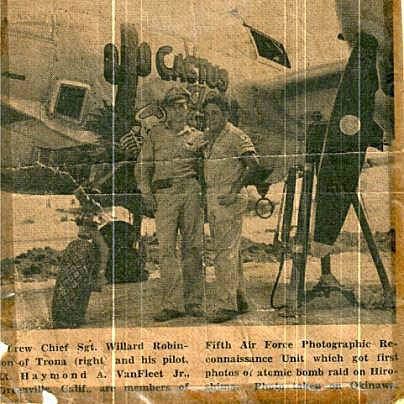

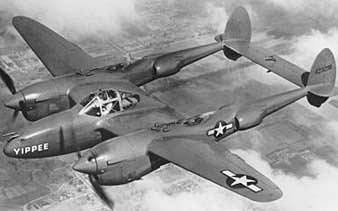 (Click to Enlarge)
(1.) 1945 photo (source: C. Robinson) (2.) B-29 Superfortress. (3.) P-38 Lightning. (USAF photos)
(Click to Enlarge)
(1.) 1945 photo (source: C. Robinson) (2.) B-29 Superfortress. (3.) P-38 Lightning. (USAF photos)
The 1945 newspaper photo caption (above left) reads: Crew Chief Sgt. Willard Robinson of Trona (right) and his pilot Haymond A. VanFleet Jr. of Danville, Calif. are members of Fifth Air Force Photographic Reconnaissance Unit which got first photos of atomic bomb raid on Hiroshima... The Photo Recon Unit flew Boeing B-29 Superfortress bombers over Hiroshima (photo above). A P-38 Lightning fighter (photo above) is in the background of the newspaper photo.
"My dad, Willard Robinson (photo on left), was a Staff Sergeant in the Army Air Corp, 25th Photo Recon, 5AF, throughout the Pacific theater, including New Guinea, Solomons, Saipan, and Okinawa. He was also at Tokyo Bay for the surrender. He never discussed his experiences, but I have a letter he wrote to his Mom after V-J Day about many of his war experiences (censorship being turned off). He was an auto mechanic for most of his life with the last decade doing what he liked most, decorative and artistic welding. My wife's father, who was from Okinawa, was drafted (as were many Okinawans) into the Japanese Imperial Army and was captured on Saipan. He spent remainder of war as a POW in Hawaii until repatriated. He returned to being a rather successful pineapple, sugar cane, and pig farmer the rest of his life in northern Okinawa." - C. Robinson
"My uncle Harry, served in the Navy as a pilot, and was credited with single-handedly sinking a German submarine. He was awarded a medal for his action. My mother's uncle was in the Navy and was in the Battle of Midway." - "Goody"
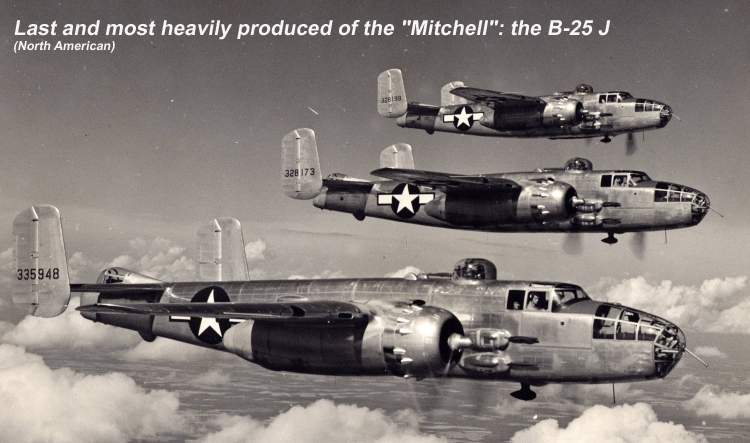 (Click to Enlarge) North American B-25 Mitchell twin-engine medium bombers. (USAF photo)
(Click to Enlarge) North American B-25 Mitchell twin-engine medium bombers. (USAF photo)
"My father was in the USAAF and was a B-25 (photo on left) and B-29 bombardier (photo above) during and after World War II. He was stationed in Guam from early 1942 to 1943; and in the Caribbean from 1943 to 1944. My dad flew in both theaters performing "anti-submarine" patrols in B-25s.
The only traumatic story he ever told me was when he was on a moonless patrol one night near Dutch New Guinea when he and the B-25 crew encountered three surfaced German submarines, one fueling sub and two attack subs. The attack subs were refueling, one on the starboard side and one of the port side. I will never forget the tears in my hero's eyes when he told me that he took out all three subs with a single bomb.
Like many World War II veterans, he did not talk much about his exploits during the war. However, he had many stories about the Norden bombsight on which he worked extensively and the B-29s on which he flew many times after WWII." - R. Mundwiller

 (Click to Enlarge) (1.) A North American B-25 Mitchell twin-engine medium bomber dropping "parafrag bombs" (parachute-retarded fragmentation bombs) on the Japanese Toyohara Air Base, Taichung, Taiwan in 1945 (link below). (2.) B-25 bombers attacking the Japanese Lamsepo Airfield at Linkou, Taiwan, April 14, 1945 (link below). Parafrag bombs are being dropped from a B-25's bomb bay. Tracer rounds from a B-25's nose-mounted .50 caliber machine guns are visible to the right of Mount Kuanyin in the distance. (U.S. military archives photos) Shulinkou: World War II - U.S. Bombing Raids on Linkou and Taiwan (Click Here)
(Click to Enlarge) (1.) A North American B-25 Mitchell twin-engine medium bomber dropping "parafrag bombs" (parachute-retarded fragmentation bombs) on the Japanese Toyohara Air Base, Taichung, Taiwan in 1945 (link below). (2.) B-25 bombers attacking the Japanese Lamsepo Airfield at Linkou, Taiwan, April 14, 1945 (link below). Parafrag bombs are being dropped from a B-25's bomb bay. Tracer rounds from a B-25's nose-mounted .50 caliber machine guns are visible to the right of Mount Kuanyin in the distance. (U.S. military archives photos) Shulinkou: World War II - U.S. Bombing Raids on Linkou and Taiwan (Click Here)
"My father enlisted in the Navy right after the Pearl Harbor attack, and was sent to Pearl Harbor for the war's duration fixing torpedoes. God bless all the vets." - "Young'un"
"My dad served in World War II as a combat engineer with the AAF. He enlisted on December 8th, 1941 and after a stint in Panama was transferred to Hawaii. He than served in the Philippines, Saipan, Tarawa, and one other island campaign. He talks about his friends, the good times they had, and the closeness they felt for each other, but he says almost nothing of the fighting he saw." - "HT"
 (Click to Enlarge) Japanese POW Camp Fukuoka #17- Omuta, Japan. (photo source: "Under the Samurai Sword", Clarence ('Cal') Graham)
(Click to Enlarge) Japanese POW Camp Fukuoka #17- Omuta, Japan. (photo source: "Under the Samurai Sword", Clarence ('Cal') Graham)
"My dad was with the Army Engineers and served on Tinian and Saipan. His brother, my uncle, Bob Scorby, was taken prisoner at Corregidor and spent all of World War II as a Japanese prisoner-of-war, ending up at Camp Fukuoka #17 in Omuta, Japan (photo on left). I remember Pete Hull, another WW II vet, telling me how uncle Bob would pick him and another kid up under his arms and pack them around. Bob joined the Army at over 200 pounds and was released at the end of the war at 125. He was a longshoreman the rest of his life. Fellow POW, Clarence Graham, wrote a book, "Under the Samurai Sword" (excerpt follows), about his war experiences, and made reference to my uncle Bob, as the toughest man he ever knew." - G. Scorby (1957-58)
POW Camp Fukuoka #17 (Click Here) "...Bob Scorby, had been a powerfully built man in peace time. He had been a bouncer in a saloon, but never drank. 'Four ax handles across the shoulders and four ax handles tall' is how they used to describe him. He was always kind and gentle though, a real nice kind of guy. Now he was just a big frame of bones with loose skin hanging over them. He was a great inspiration to me [Clarence Graham]. He had a great desire to live. He never swore or held a grudge, and always had a great respect for the Lord. He used to tell me that if he ever got out of that prison camp alive, he would never let his stomach be empty again. He did make it back, and he did live up to his word to his dying day." (excerpt source: "Under the Samurai Sword", Clarence ('Cal') Graham)
 (Click to Enlarge) Merchant Marine "Liberty Ships" under construction during WWII. (photo credit: unknown)
(Click to Enlarge) Merchant Marine "Liberty Ships" under construction during WWII. (photo credit: unknown)
"My dad was a welder in a shipyard on December 7th, 1941, when went down and got in line to enlist. When they got to the occupation part of his paper work, my dad told them he was a welder in a shipyard. They told him to get back to the shipyard and put some guns on the ships. That is what he did until the war was over. The ship builders got so good, they turned out a Merchant Marine ship every 45 days, from laying the keel to launching it. My dad did his part and I couldn't be any prouder of him." - R. Swift (1957-58)
"My father was too old for World War II, but did manage to travel to France for World War I." - B. Martin (Shulinkou: 1963-67 & 1970-75)
 "My dad served with the Navy in 1945, having just turned seventeen. By that time the war was pretty much wrapped up. He was kept stateside on the Potomac.
His brother Nick also served in the Navy in the Pacific Theater. He was supposed to be on the Yorktown, but was shipped to a relay station in the Johnson Islands to pick up downed pilots with PBY's (photo on left). My mothers uncle was with the Army in the Pacific. My wife's father was a cook during and after D-Day, serving in France. He told me many times when they bugged out of an area, and being one of the last to leave, he could see the Germans moving into the area they just vacated."- R. Riccitello
"My dad served with the Navy in 1945, having just turned seventeen. By that time the war was pretty much wrapped up. He was kept stateside on the Potomac.
His brother Nick also served in the Navy in the Pacific Theater. He was supposed to be on the Yorktown, but was shipped to a relay station in the Johnson Islands to pick up downed pilots with PBY's (photo on left). My mothers uncle was with the Army in the Pacific. My wife's father was a cook during and after D-Day, serving in France. He told me many times when they bugged out of an area, and being one of the last to leave, he could see the Germans moving into the area they just vacated."- R. Riccitello
(Click to Enlarge) PBY-5 Catalina landing on water during WWII. (photo source: "en.wikipedia.org")
(Click to Enlarge) "My dad (photo on left) served on various islands in the South Pacific. He seldom spoke of his time in the service but I have a number of photos of him and fellow sailors in the South Pacific. He was awarded a Bronze Star and used to laugh about telling new recruits to dig foxholes at least five feet deep. When asked why so deep, he said he was going to jump in first so the new guy was on top of him for the strafing. My grandparents all immigrated to America so my dad was the first in his family to fight for the USA in wartime." - J. Hanretty (photo source: J. Hanretty)
"My father was too old to serve in World War II, but was a fireman and policeman during that time frame. His brother, my uncle, was killed on Saipan. My other uncle on my mother's side (both uncles enlisted in the Marines together the same day in Los Angeles), was badly wounded and was sent back to Camp Pendleton where he met a nurse, who eventually became his wife and my aunt. Neither really talked about anything having to do with the war or their parts in it." - "LT"

 (Click to Enlarge) (1.) 1944 newspaper photo of Corporal Charles Jenkins and his B-24 crew. (2.) Charles Jenkins. (photos source: C. Jenkins)
(Click to Enlarge) (1.) 1944 newspaper photo of Corporal Charles Jenkins and his B-24 crew. (2.) Charles Jenkins. (photos source: C. Jenkins)
"My dad (photos on left) served with the 8th AAF during Word War II. During 1944 and 1945 he was a radio operator, gunner, and mechanic on B-24 Liberators flying over Germany from an Allied air base located near Norwich, England. He did not talk much about his service.
On one memorable mission my dad and crew, flying in an older B-24 Liberator, took off before dawn in heavy fog and overcast conditions. Because of bad weather over the English Channel, the flight group was to assemble over the coast of France, where clear weather was forecast. However, heavy cloud cover and poor visibility prevailed at the assembly point. To make matters worse, they had to fly blind in heavy clouds at low altitude due to malfunctioning navigational and oxygen systems on their B-24. The bad weather and equipment problems, combined with the possibility of colliding with the hundreds of other planes assembling in the area, forced the pilot to return to England.
The pilot, flying blind without navigational equipment, instructed my dad to attempt to get a bearing via radio from their base in England to return home. The fate of the plane and crew depended on receiving that critical compass heading. At the base's request, my dad transmitted a long dash on his radio with his Morse code key. The base replied with a compass heading followed by 'QDY' in the message, instead of the expected 'QDM' (magnetic heading). 'QDY' indicated they were heading directly toward barrage balloons, which posed a very serious threat flying at their low altitude with limited visibility. To avoid the balloons, in the event the message was correct, my dad took immediate action and advised the pilot to veer slightly to the north of their present course.
Subsequently, my dad requested and received another bearing followed by a confirming 'QDM' in the radio message. This new compass heading was used by the pilot to set a course to return home.
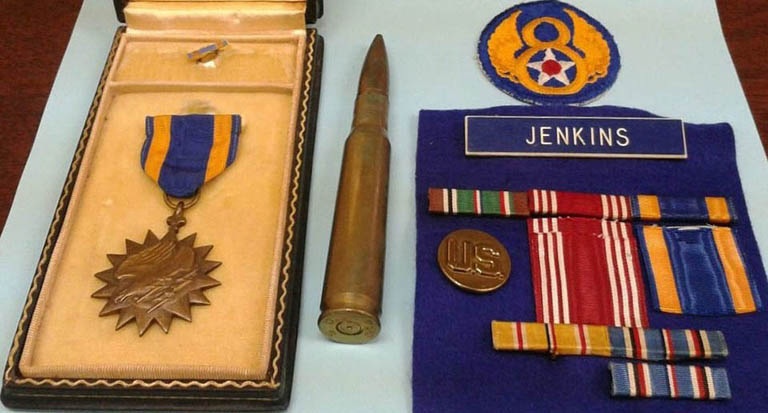 Fortunately, when their plane finally broke through the cloud cover over the Channel the English coast was in sight. Firing colored flares to identify themselves to the English artillery, they safely landed at their home base seven hours after suiting up.
Fortunately, when their plane finally broke through the cloud cover over the Channel the English coast was in sight. Firing colored flares to identify themselves to the English artillery, they safely landed at their home base seven hours after suiting up.
Back on the ground the pilot put his arm around my dad’s shoulder and said, 'Charlie, we might not have made it back if you hadn't known what to do. Anything you want, just say the word, and I’ll make it happen'. My dad replied, 'Well, I am up for promotion...'. The pilot started the paperwork that day. So, my dad was promoted to Staff Sergeant, and was also awarded the Air Medal (Click Here) for his actions that day.
Germany surrendered my dad was sent to the states for transfer to the Pacific Theater. Those plans were put on hold when the Japanese surrendered." - C. Jenkins
(Photo on Right-Click to Enlarge) (L-R) SSgt. Charles Jenkins' WWII Air Medal, .50 caliber machine gun round, 8th AAF patch, and service ribbons. (photo source: C. Jenkins)
 (Click to Enlarge) Lieutenant James Valkwitch standing next to a P-39 Bell Airacobra before he was trained on Mustangs. (photo source: J. Valkwitch)
(Click to Enlarge) Lieutenant James Valkwitch standing next to a P-39 Bell Airacobra before he was trained on Mustangs. (photo source: J. Valkwitch)
My father, was drafted into the Army about 1943-44. He wasn't sent overseas having lost his older brother, James, during the war. Coincidentally, my dad was also a ditty-chaser, for the Army (ASA).
"His brother, my uncle, Lt. James Valkwitch, flew P-51 Mustangs for the 362nd Fighter Squadron, 357th Fighter Group out of Leiston, England. He was killed in action, 13 Sept 1944, on his second mission during "The Arnhem Affair", Operation Market Garden (Netherlands and Germany). Allied aircraft losses on that day were: ten B-24 Liberators, seven B-17 Fortresses, five P-51 Mustangs, and one Hurricane (photos on right). 23 downed aircraft in one day of a long war illustrates the scale of the sacrifices that were made.
 My uncle was 22 years old when he died and was married just before he left for England. He went into the Army Air Corps as a pilot having learned how to fly prior to the war with his best friend, John Sutton. John flew C47's over the "Hump", India to China.
My uncle was 22 years old when he died and was married just before he left for England. He went into the Army Air Corps as a pilot having learned how to fly prior to the war with his best friend, John Sutton. John flew C47's over the "Hump", India to China.
My dad never spoke much about his brother. I learned more about him on the internet than from my dad. Through my research my dad and I were invited to the last reunion of the 357th fighter group. which was held at Wright Patterson AFB, Dayton Ohio, in Sept 2001. My mom and dad went to the reunion hoping to find people who knew his brother. Unfortunately, the one man who did know him had died a few months before the reunion, but his wife was there. During the reunion, two famous ace's of the 357th, Chuck Yeager and Bud Anderson, did a flyover in vintage Mustangs.
My wife's father was an officer in the Chinese Army and spoke Japanese and English as well as Chinese. He was a liaison officer after the war at General MacArthur's headquarters in Japan." - J. Valkwitch (NSG)
(Photo on Right-Click to Enlarge) Front to back: Consolidated B-24 Liberator, Boeing B-17 Flying Fortress, and North American P-51 Mustang. (image credit: unknown)
"My dad enlisted in the Navy as a lawyer when the war started. He mustered out before the war ended, but was then was drafted into the Army. My wife's dad flew a B-17 (photo on right above), named the "Wolf's Nest", in the 94th Bomb wing, 333rd Squadron. He flew 19 missions before the war ended in Europe." - P. Chamlee
"My dad was drafted out of Gallaudet College in Washington, D.C. in 1942, but was eliminated since he had been deaf since childhood. Both of his brother's served after WWII, the youngest was a radioman in Vietnam who was shot in the shoulder while on patrol. My wife's father was a bombardier in B-17s or B-24s (photo on right above) in North Africa during WWII. He was truly proud to be part of the 'Greatest Generation'." - A. Roberts
 (Click to Enlarge) LST 830 in the Pacific during WWII. (photo credit: unknown)
(Click to Enlarge) LST 830 in the Pacific during WWII. (photo credit: unknown)
"My dad was in 'D' Company, 1301st Engineers, Third Army, which had one command company with five companies scattered all over Europe. The only time all five companies of the 131st Engineers worked together was to build the first unlimited weight load bridge across the Rhine. When the Battle of the Bulge began, 'D' Company was only 12 miles from Bastogne. My dad rarely spoke of the war. My uncle Stan was on the LST 830 (photo on left) at Okinawa. Three were wounded on deck and their sister LST was hit by a Kamikaze that just missed the LST 830. My uncle John was on two ships that were sunk by German torpedoes in the Atlantic." - "OK"
 (Click to Enlarge) 6th Division Marine demolition crew watches explosive charges on Okinawa. (photo source: "en.wikipedia.org" )
(Click to Enlarge) 6th Division Marine demolition crew watches explosive charges on Okinawa. (photo source: "en.wikipedia.org" )
"During World War II, my father, as a Lieutenant Colonel, was a G-2 intelligence observer for the Army Ground Forces in Italy. After he returned from Italy, he was deputy and executive officer in the office of the G-2 for Army ground forces. Discovering that he could not get promoted to full Colonel in that capacity, he volunteered for duty in the Pacific Theater of Operations and was temporarily promoted to Colonel.
MacArthur believing that he was going to have to invade the Chinese mainland sent thirty full colonels to Yale University for a six month crash course in history, culture and language. Following the course at Yale, my Dad was assigned to the Division Artillery 27th Infantry Division which was training on an island (Espiritu Santo) for the invasion of Okinawa. The Army had replaced almost all of the NY National Guard field grade officers with Regular Army officers in the 27th Division after Marine Corps Lieutenant General H. M. (Howlin' Mad) Smith had relieved the Army Major General Smith, commander on Saipan.
My father was not in the first wave and probably not in the second wave to hit the beach in Okinawa. What he did tell me is that he was never so happy to get his feet on the ground and get off the ship because of the kamikaze attacks by the Japanese. He belatedly found out that you can't dig a foxhole or a bunker on board a ship made of steel. If I am not mistaken, the Navy lost more people and ships in Okinawa than they did in the entire Pacific, primarily because of the kamikazes and dive bombers.
 On Okinawa, he alternately with a Marine colonel. ran a gunfire support tactical operations center that controlled 32 battalions of Marine and Army field artillery and the offshore guns on supporting Navy vessels. Following the Okinawa campaign and the bombing of Hiroshima and Nagasaki, the Japanese surrendered and my father remained as a rear commander on Okinawa. Shortly after the surrender, my father's temporary grade of Colonel reverted back to his permanent regular Army rank of Lieutenant Colonel. During the occupation of Japan, my father commanded the 99th Field Artillery Battalion in the 1st Cavalry Division.
On Okinawa, he alternately with a Marine colonel. ran a gunfire support tactical operations center that controlled 32 battalions of Marine and Army field artillery and the offshore guns on supporting Navy vessels. Following the Okinawa campaign and the bombing of Hiroshima and Nagasaki, the Japanese surrendered and my father remained as a rear commander on Okinawa. Shortly after the surrender, my father's temporary grade of Colonel reverted back to his permanent regular Army rank of Lieutenant Colonel. During the occupation of Japan, my father commanded the 99th Field Artillery Battalion in the 1st Cavalry Division.
Subsequently, my dad was again promoted this time to the permanent rank of Colonel at Fort Sill, where he served as G-4 (supply and logistics), later as the professor of military science at Boston College, inspector general of the Caribbean and First Army, and ended his career as the last commander of Boston Army Base. He retired from the Army in 1958, having graduated from the U.S. Military Academy in 1928." - B. Thayer (ASA, Shulinkou: 1960-63, Taipei: 1973-77)
(Click to Enlarge) Marines moving artillery on Okinawa. (DOD photo, USMC)
Following are links to several websites of the official histories of World War II:
Marianas Campaign in World War II (Click Here)
U.S. Marine Corps in World War II (Click Here)
U.S. Navy in World War II (Click Here)
U.S. Army in World War II (Click Here)
U.S. Army Air Force in World War II (Click Here)
|
|